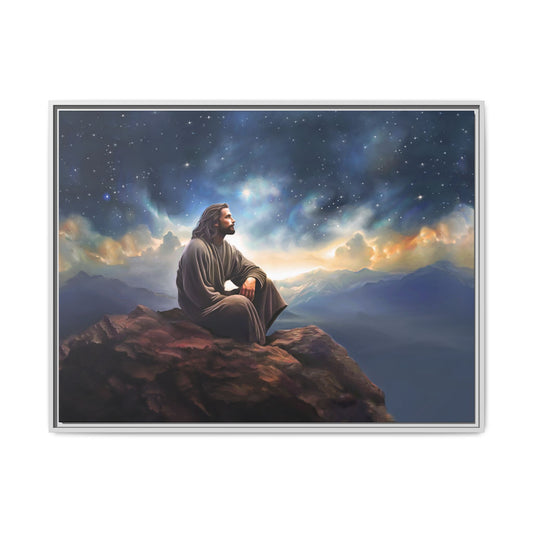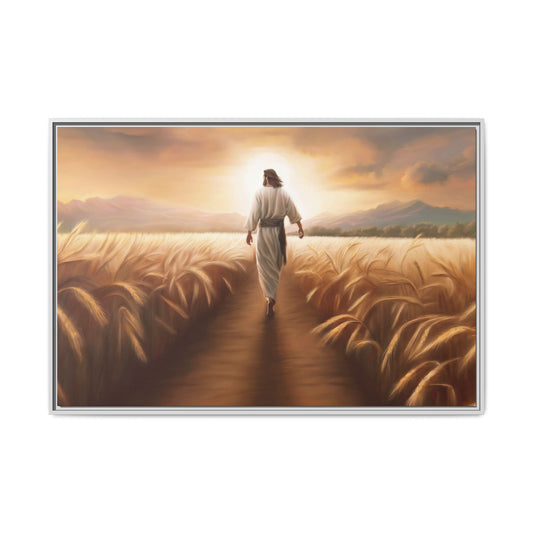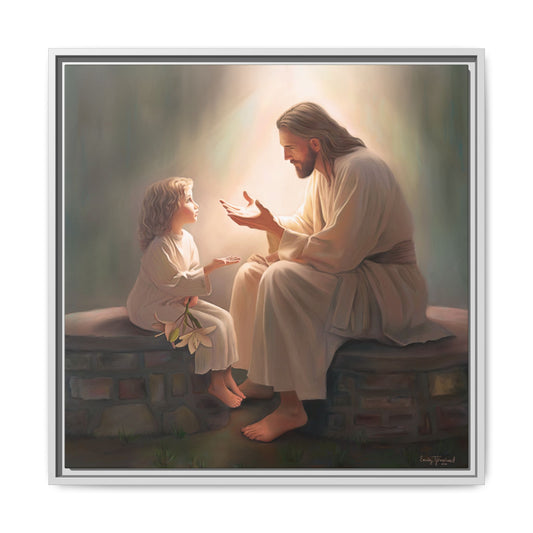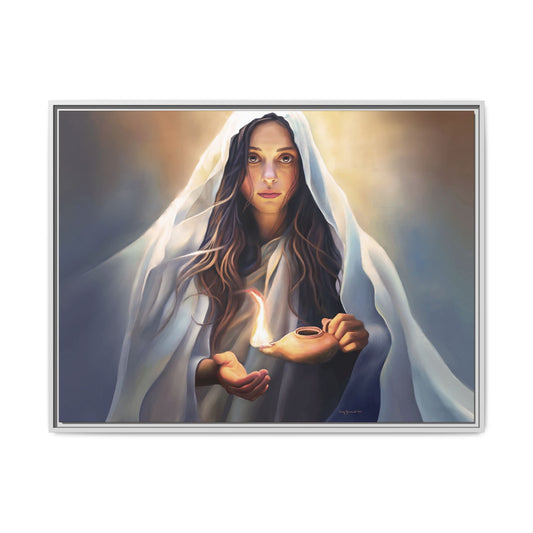Michelangelo's Jesus Christ
Share
We, as art historians, have long been fascinated by the works of Michelangelo. His depictions of Jesus Christ capture the very essence of faith and artistry, and his works have shaped the history of art.
From the Sistine Chapel to the Last Judgment, Michelangelo's masterful portrayals of Jesus Christ have been studied and interpreted throughout the centuries. The beauty and skillful execution of these works bring us an intimate glimpse into divine beauty and a deeper understanding of the timeless legacy of Michelangelo's art.
Key Takeaways
- The Last Judgment is an important moment in Christian belief, representing the end of time and the beginning of eternity.
- Michelangelo's Last Judgment is a powerful portrayal of this moment in Christian art, with over 300 muscular figures arranged in tiers and quadrants.
- The composition of the Last Judgment rises on the left and descends on the right, resembling the scales used in depictions of the Last Judgment.
- The depiction of the elect (those going to heaven) in the Last Judgment reaffirms the Catholic doctrine that faith, divine grace, prayer, and good works all play a part in salvation.
Michelangelo's depiction of Jesus Christ
Michelangelo is one of the most celebrated artists of the Renaissance period. His portrayal of Jesus Christ is a major part of his artistic legacy. In this article, we'll explore how Michelangelo depicted Jesus Christ in his artworks and why this representation is so significant.
We'll also discuss the various topics associated with Michelangelo's depictions of Jesus Christ.
Briefly introduce Michelangelo as a renowned artist
We marvel at Michelangelo's depiction of Jesus Christ, a masterpiece of Renaissance painting that stands as a testament to the artist's skill and faith.
Michelangelo's artwork is renowned for its beauty, detail, and insight into the human condition. His approach to art was deeply rooted in the Renaissance humanist tradition, which sought to capture divine perfection. His works demonstrate an appreciation of the God-designed human body and a belief that true art is a reflection of divine perfection.
His famous artworks include The Pieta, The Statue of David, Madonna and Child (Madonna of Bruges), Moses, The Last Judgment, and The Conversion of Saul.
Michelangelo's faith and dedication to his craft inspire and influence artists today. His legacy is one of service to God and a passion for perfection.
Discuss the significance of his portrayal of Jesus Christ in his artworks
We explore the significance of Michelangelo's portrayal of Jesus Christ in his artworks. His works, such as the Pieta, the Statue of David, and the Last Judgment, all feature Christ in some way. The Pieta depicts Jesus on the lap of Mary after the Crucifixion, the Statue of David portrays him before his battle with Goliath, and the Last Judgment shows the final judgment of souls. Each of these scenes captures a different aspect of Jesus's life, demonstrating Michelangelo's deep understanding and reverence for Christ.
The Sistine Chapel painting also reveals Michelangelo's faith in his art. He believed creating something perfect was a religious endeavor, and his detailed statues demonstrate his appreciation for the God-designed human body. Michelangelo's portrayal of Jesus in his artworks remains a source of inspiration and influence for artists today. His faith and dedication to his craft serves as a reminder of the power of art to capture the beauty and divinity of Jesus Christ.
This article will now move on to mention the various topics that will be covered in the article.
Mention the various topics that will be covered in the article
Continuing from our discussion of Michelangelo's faith and dedication to his craft, we'll now look at the various topics that will be covered in this article regarding his depiction of Jesus Christ:
- The historical and religious significance of his portrayals
- His approach to art and its influence on his depictions
- The composition and symbolism of his paintings
- The portrayal of the elect and the damned
- His legacy and impact on future art.
Michelangelo's profound faith and dedication to his craft are evident in his renderings of Jesus Christ. From the Pieta to the Last Judgment, Michelangelo's paintings have stood the test of time and continue to inspire and influence artists today. His paintings are characterized by an incredible attention to detail, a profound understanding of symbolism, and a humanistic approach to art that captures the beauty and transcendence of God's creation.
Michelangelo's Jesus Portraits: A Glimpse into Divine Beauty
Michelangelo's portrayals of Jesus Christ are some of the most iconic images in art history.
Through his works, we can gain a glimpse into the divine beauty of Jesus, from the solemnity of his face in the Pieta to the serene grandeur of his figure in the Statue of David.
Through these works, Michelangelo conveys his reverence for the divine while at the same time capturing the humanity of Jesus in a unique way.
Explore Michelangelo's portrayal of Jesus Christ in his paintings and sculptures
We will explore Michelangelo's portrayal of Jesus Christ in his paintings and sculptures. We will examine the techniques he used to bring life and emotion to these divine figures.
Through careful analysis of the artworks, we'll gain a glimpse into the divine beauty that Michelangelo sought to capture.
: Discuss the famous Michelangelo Jesus painting in the Sistine Chapel
Let's take a closer look at the iconic Jesus painting that Michelangelo created for the Sistine Chapel.
Michelangelo's Jesus Christ painting was created to reflect God's glory and serve as a reminder of His divine power and love. This masterpiece has an unrivaled artistic beauty, which conveys a deeper meaning for its audience.
It contains elements of divine grace, love, and prayer, and is symbolic of the struggle between good and evil. Michelangelo's Jesus Christ painting is a timeless reminder that faith, faithfulness, and good works are essential to salvation.
: Analyze the style and techniques used by Michelangelo to depict Jesus
Zooming in on Michelangelo's depictions of Jesus, we can observe the divine beauty of his artistry. In sculptures and paintings alike, he masterfully captures the figure of Jesus in a way that's emotionally evocative.
Michelangelo conveys Jesus' divinity using the techniques of classical composition, light, and shadow, as well as subtle details like ornate drapery. His style of artistry conveys a sense of awe and reverence, and his bold use of color amplifies the emotional impact of his works.
His works of Jesus show a deep respect and admiration, highlighting his faith and devotion to the Lord.
: Examine the emotional impact and reverence evoked by the paintings
As viewers, we're awestruck by Michelangelo's divine beauty and reverence in his paintings of Jesus Christ. His depictions of Christ evoke a profound emotion, from the iconic Pieta to the Last Judgment fresco on the Sistine Chapel ceiling. Here are five key components of his art that contribute to this effect:
• Faith: Michelangelo captures Christ's divine nature and faith in God.
• Detail: His sculptures and paintings are filled with intricate details and symbolism.
• Movement: His figures are dynamic and powerful, conveying a sense of awe.
• Emotion: His figures are lifelike and express emotion in a naturalistic manner.
• Perfection: Michelangelo's art exemplifies divine perfection, conveying a sense of reverence.
The Life and Works of Michelangelo: Shaping Jesus Portraits
We explore the life and works of Michelangelo, examining how his religious beliefs and experiences shaped his Jesus portraits.
Through his art, Michelangelo sought to capture the beauty and holiness of Jesus Christ.
His works demonstrate a reverence for the divine and an understanding of the transformative power of art.
Provide a brief overview of Michelangelo's life and his artistic career
How have Michelangelo's life and works shaped his depictions of Jesus Christ?
His Humanist approach, detailed statues, and appreciation for the human body all reflect a reverence for God as the Creator.
His faith in God and dedication to his craft are evident in his letters and quotes, and his famous artworks like The Pieta, The Statue of David, and The Last Judgment demonstrate his mastery of painting and sculpture.
Michelangelo's:
• Humanist approach
• Detailed statues
• Appreciation for the human body
• Faith in God
• Dedication to craft
have all served to shape his depictions of Jesus Christ in a way that conveys divine perfection, beauty, and transcendence.
Discuss the influences and experiences that shaped his portrayal of Jesus Christ
Exploring Michelangelo's life and works reveals the influences and experiences that shaped his portrayal of Jesus Christ. His sculptures, paintings, and drawings are the result of his religious and humanist beliefs, which can be seen in his use of marble and the power of his depictions.
His sculptures, such as The Pieta, David, and Moses, demonstrate his appreciation for the divinely designed human body. In his painting of the Last Judgment, Michelangelo aimed to affirm the legitimacy of the Catholic Church and its doctrines. His religious faith can be seen in the tenderness of his portrayals of Jesus Christ.
In his work, Michelangelo sought to capture a prophet that wasn't only religious, but also human. His vision of Jesus as a symbol of strength and beauty has been immortalized in marble, inspiring countless generations of artists.
Explore how Michelangelo's religious beliefs influenced his artistic choices
Drawing on his faith, Michelangelo's works of art reflect his religious beliefs and his commitment to capturing a human, yet divine Jesus. His approach to art was deeply rooted in his deep love for God and his desire to serve Him. He believed that creating something perfect was a religious and pure endeavor, and sought to demonstrate the glory of God as the Creator through his detailed statues.
Michelangelo's faith is evident in his paintings and sculptures, including the Pieta, the Statue of David, and the Last Judgment. He portrayed Jesus as a symbol of strength, beauty, and grace, using the Gospel of John and other biblical accounts for inspiration. Michelangelo's work serves as a reminder of the power of faith, divine grace, and prayer in finding salvation. His commitment to creating masterpieces that reflect his religious beliefs serves as an inspiration for others to follow.
The Sistine Chapel: A Haven of Michelangelo's Jesus Portraits
We explore the Sistine Chapel, a haven of Michelangelo's Jesus portraits, to better understand the significance and history of the chapel.
We also aim to explore the impact of Michelangelo's portrayals of Jesus on those who visit.
Delve into the significance and history of the Sistine Chapel
We can't begin to discuss Michelangelo's Jesus Christ without delving into the significance and history of the Sistine Chapel, a haven of his Jesus portraits.
The chapel was commissioned by Pope Julius II in 1508 and Michelangelo was put in charge of its decoration. He painted nine scenes from the Book of Genesis on the ceiling and the Last Judgment behind the altar. His works revolutionized painting with perspective and distribution of figures, and inspired other artists to follow his techniques.
His depictions of Jesus Christ were an embodiment of his Humanist philosophy and faith in God. His artworks are still considered masterpieces of Western art, and his approach to art as a means of serving God is still relevant today.
With this in mind, let's now explore the different Jesus portraits found in the Sistine Chapel.
Explore the different Jesus portraits found in the Sistine Chapel
We are going to explore the different representations of Jesus that Michelangelo has painted in the Sistine Chapel.
We'll start with the creation of Adam and end with the Last Judgment.
We'll look at the symbolism and meaning behind these scenes.
We'll also examine the impact they've had on the art world.
: Discuss the portrayal of Jesus in the Creation of Adam
Together we explore the different Jesus portraits that Michelangelo placed in his masterpiece, The Creation of Adam, at the Sistine Chapel.
From the majestic figure of Christ in The Last Judgment to the iconic sculpture of David, Jesus is the focus of Michelangelo's art.
The fresco of Creation of Adam portrays Jesus as the source of life, linking God to His people.
The Sistine Chapel Ceiling highlights the redemption of Man through Jesus.
The Pieta shows the humanity of Jesus in his death.
The statue of David conveys Jesus' strength and power.
The Last Judgment reveals the judgment of the wicked and the salvation of the righteous through Jesus.
Michelangelo's works at the Sistine Chapel reveal his deep faith and understanding of Jesus.
: Analyze the depiction of Jesus in the Last Judgment
Analyzing the Last Judgment, it's clear that Michelangelo created a powerful portrayal of Jesus Christ. His figure stands at the center, surrounded by a flurry of sculpted figures that signify a tug of war between angels and demons for the souls of the damned.
The artist highlighted the good works of the elect, like prayer, which is symbolized by a pair of souls clinging to a strand of rosary beads. Each figure conveys a different sin, like avarice and pride, and the overall composition is meant to involve the viewer in the impending judgment.
Michelangelo's sculpture captures the essence of his faith and the beauty of his art.
Highlight the impact of Michelangelo's Jesus portrayals on the visitors of the chapel
Visitors to the Sistine Chapel are often struck by the power and emotion of Michelangelo's iconic portrayals of Jesus. In his fresco, The Last Judgment, Jesus is depicted as the central figure, surrounded by the blessed and the damned. His presence arouses a sense of awe in viewers, which is further enhanced by the composition, symbolism, and detail of his portrayals.
The impact of Michelangelo's Jesus portraits on viewers is evident in the way they're drawn to the chapel to experience the divine. From the Pieta to the Conversion of Saul, Christ's presence serves as a reminder of the power of faith and grace. Michelangelo's artworks also inspire viewers to serve their Church and community, emphasizing the importance of Christ's teachings and examples.
- Michelangelo's artworks help viewers to better understand the Church's beliefs
- His art serves as a reminder of the power and beauty of Jesus
- His portrayals of Christ evoke a sense of awe and wonder
- His works emphasize the importance of faith and grace
- His art inspires viewers to serve their Church and community
Michelangelo's Jesus Portraits: Capturing the Essence of Christ
Michelangelo's Jesus portraits are renowned for their beauty and religious significance. Through his creative choices, Michelangelo sought to capture the essence of Christ in his works.
To this end, every detail of Jesus' facial expressions, gestures, and body language was carefully considered and crafted.
Discuss how Michelangelo's Jesus portraits captured the essence of Christ
We can feel Michelangelo's reverence for Jesus Christ in his powerful portraits. His works are considered masterpieces of Western art, exemplifying his faith in God's glory as the Creator. Through his art, Michelangelo aimed to capture the essence of Christ. His unique approach included:
• Upholding the Catholic doctrine that faith, prayer, and good works all play a role in salvation.
• Demonstrating appreciation for the God-designed human body with detailed statues.
• Reflecting divine perfection through his belief that true art is a reflection of God.
• Serving for the love of God and putting all his hope in Him.
• Believing he was designated for his work by God.
Michelangelo's Jesus portraits embody his Christian faith and are a testament to the power of art.
Explore the symbolism and religious significance behind his creative choices
Building on Michelangelo's reverence for Jesus Christ, we explore the symbolism and religious significance behind his creative choices in capturing the essence of Christ in his portraits.
His works are lauded as some of the most iconic portrayals of the saint's life, with the Last Judgment and the Pieta widely acclaimed.
In each painting, Michelangelo skillfully integrated religious symbolism to reinforce the story of Christ's life. For example, the Pieta features a rosary, symbolic of the religious devotion of Mary. The Last Judgment presents a tug of war between angels and demons representing the struggle between good and evil.
Michelangelo's work serves as a reminder of the power of faith and the importance of living a religious life.
Analyze the portrayal of Jesus' facial expressions, gestures, and body language
Continuing our exploration of Michelangelo's reverence for Jesus Christ, we now analyze the portrayal of Jesus' facial expressions, gestures, and body language in his portraits.
The face of Jesus is always depicted with a sense of holiness, humility, and compassion. His head is framed by gentle rays of light, symbolizing his divine nature. His beauty is timeless, capturing the power of his message and the hope of salvation.
His gestures are often interpreted as ones of blessing, while his body language conveys his grace and mercy. Through these features, Michelangelo conveys the essence of Jesus Christ in his works.
These elements form a legacy of faith and artistic excellence.
Michelangelo's Jesus Portraits: A Legacy of Faith and Artistic Excellence
Michelangelo's Jesus portraits have remained an enduring legacy for centuries, inspiring countless generations of artists and viewers alike. His works captivate with their intricate details and powerful symbolism, representing a deep-seated faith and unparalleled artistic excellence.
Even today, his Jesus portraits continue to draw admiration and appreciation from viewers around the world.
Discuss the enduring legacy of Michelangelo's Jesus portraits
We explore the enduring legacy of Michelangelo's Jesus portraits and how they continue to inspire faith and artistic excellence. From early people to the modern age, his works have influenced many:
- His approach to art emphasized the divine Creator in all of his work.
- His sculptures and paintings are considered masterpieces of Western art.
- His faith in God is evident in his letters and quotes.
- His perfectionistic tendencies caused many works to remain unfinished.
- He captured the details of the human body with grace and beauty.
Michelangelo's Jesus portraits reflect a deep respect for the divine and have shaped later generations of artists.
Examine the influence of Michelangelo's works on later generations of artists
Building on Michelangelo's legacy of faith and artistic excellence, we explore the influence of his Jesus portraits on later generations of artists.
His iconic works, such as the Last Judgment in the Sistine Chapel and the Pieta, have inspired many artists in the centuries since his death.
Oil paintings created by later generations of artists have drawn heavily on Michelangelo's style, with artists taking his images and reinterpreting them in their own ways.
His works have also been used as the basis for sculptures, frescoes, and other forms of art.
Michelangelo created a lasting legacy of faith and art, and his works continue to inspire artists today.
Highlight the continued relevance and appreciation of his Jesus portraits in the modern era
Over the centuries, Michelangelo's Jesus portraits have continued to captivate viewers with their intricate detail, artistry, and compelling message of faith. His original painted works, such as the Pieta and The Last Judgment, are timeless classics. Here are five reasons why his Jesus portraits remain so great:
- They embody the Renaissance Humanist approach of seeing God's glory in the beauty of the human form.
- They demonstrate Michelangelo's belief in the importance of beauty and perfection in art.
- They showcase his technical skill and mastery of sculpture and painting.
- They evoke emotion and serve as a reminder of faith and salvation.
- They provide an inspiring example of dedication and passion for one's craft.
Michelangelo's Jesus portraits are a legacy of faith and artistic excellence that will continue to captivate viewers for generations to come.
Conclusion
We have discussed the profound influence of Michelangelo's Jesus portraits on art and spirituality. Through his work, we can see how art can be used to express reverence for Jesus Christ.
It's now time to explore the lasting power of his legacy.
Summarize the key points discussed in the article
Wrapping up, we've summarized the significance of the Last Judgment in Christian belief, the historical and pictorial contexts of the painting, Michelangelo's life and approach to art, his famous artworks, the Sistine Chapel painting, and his legacy and impact.
To convey a deeper meaning for the audience, here are some key points:
• Michelangelo was born in Italy in 1475 and moved to Florence shortly after birth.
• His Renaissance Humanism was focused on Greek philosophy and classical thinking.
• His artworks such as The Pieta, The Statue of David, and The Last Judgment revolutionized painting with perspective and distribution of figures.
• His faith in God was seen in his letters and quotes, and his dedication and passion for his craft set an example for all artists.
• Michelangelo's work continues to inspire and influence man's arts today.
Emphasize the profound impact of Michelangelo's Jesus portraits on art and spirituality
Building on the legacy of Michelangelo's Last Judgment, his Jesus portraits continue to inspire and influence both art and spirituality today. Artists throughout history have been inspired by the beauty and precision of his works, while many believers find them to be a powerful reminder of faith and devotion. Michelangelo's Jesus paintings have been revered for centuries as masterpieces of Western art, continuing to captivate audiences with their dramatic composition and emotional resonance. The impact of these works can be seen in the spiritual and artistic realms, as they are both a source of inspiration and a reminder of the divine.
| ART | SPIRITUALITY |
|---|---|
| Beauty | Faith & Devotion |
| Precision | Inspiration |
| Composition | Divine Reminder |
| Emotional Resonance | Source of Inspiration |
Conclude with a thought-provoking statement about the enduring power of art in expressing worship and reverence for Jesus Christ
As a result of its profound beauty and powerful symbolism, Michelangelo's Last Judgment serves as a lasting testament to the enduring power of art in expressing worship and reverence for Jesus Christ.
It's a collection of figures that's timeless, inspiring awe and wonder in all who behold it.
Its impact is still felt today in the way it speaks to our souls and reminds us of the divine.
We can find solace and hope in its library of images, which beckon us to remember our ultimate purpose and destiny.
The Last Judgment serves as an eternal reminder of our faith and the love of Jesus Christ that binds us together.
Frequently Asked Questions
How Does Michelangelo's Approach to Art Reflect His Faith?
We believe Michelangelo's approach to art reflects his faith in several ways. His appreciation for the human form, use of Renaissance Humanism, and dedication to creating something perfect as a religious endeavor demonstrate his belief in God's power and beauty. His faith is seen in his art, letters, and quotes, inspiring us to serve God through our own creations.
How Did Michelangelo's Humanist Approach to Art Influence His Depiction of Jesus?
We, as Christians, find Michelangelo's humanist approach to art inspiring. He saw art as a reflection of divine perfection and dedicated himself to creating something perfect as a religious endeavor. His Last Judgment fresco, depicting Jesus in the center, is an excellent example of his skill in conveying deep emotion.
What Is the Significance of the Last Judgment in Christian Belief?
We Christians believe the Last Judgment is a pivotal moment in our faith. It marks the beginning of eternity, and reminds us of the importance of judgment and salvation. It is a reminder of our need to live godly lives and to prepare for our eternal destiny.
How Does Michelangelo's Last Judgment Painting Portray the Elect and the Damned?
We soar through Michelangelo's Last Judgment painting like eagles, observing the elect ascending on the left and the damned descending on the right. The blessed cling to rosary beads while demons drag the damned towards hell. Souls struggle between angels and demons, a tug-of-war that ultimately reflects their fate.
How Have Michelangelo's Jesus Portraits Impacted Other Artists Today?
We have seen Michelangelo's Jesus portraits inspire and influence modern artists, who strive for beauty and transcendence in their work. His dedication to craft and faith have served as reminders of the power of art to serve God and mankind.
Conclusion
We have come to appreciate Michelangelo's Jesus portraits as a testament to artistic excellence and faith.
His renderings of Jesus, full of symbolism and beauty, have left an indelible mark on the history of art, and continue to captivate us with their divine grace and power.
Through his powerful and nuanced depictions, Michelangelo has given us a glimpse of the divine, and we're forever in his debt.




